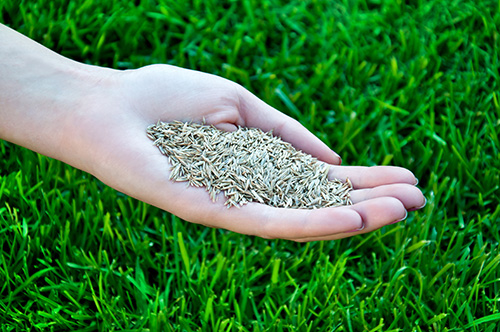There are two main ways to start a new lawn – from seeds or plants (sod, plugs and sprigs). Which one is best depends on your budget, the type of grass you want, and when you want to plant. Seed is less expensive than sod, plugs, or sprigs, but takes longer to create thick grass cover. It's also hard to get good germination from many warm-season grass seeds, which include the grasses most commonly grown in Texas.

Choosing Grass
The
National Arboretum puts Texas in three different grass-growing zones. Northern Texas falls in the Transition Zone, eastern Texas and parts of central Texas fall in the Warm/Humid Zone, and western, southern and parts of central Texas are in the Warm/Arid zone.
Transition Zone – This is a tricky zone because the cooler winters can kill warm-season grasses, but the hot summers are hard on cool-season grasses. Zoysia grass is an excellent choice for parts of Texas in this zone though you can also plant a mixture of warm-season and cool-season grasses like fescues and bluegrass.
Warm/Humid Zone – Bermuda grass is the grass most commonly grown in this zone. In northern parts of the Warm/Humid zone, zoysia grass is a reliable alternative. For southern parts of the Warm/Humid zone and along the Gulf Coast, carpet grass, bahiagrass and St. Augustine grass are good choices.
Warm/Arid Zone – Bermuda grass is also the most common grass grown in Texas's Warm/Arid zone. Buffalo grass is a more drought-tolerant alternative to Bermuda grass.
If You're Planting …
Make sure the lawn is ready before laying sod, planting sprigs and plugs, or even seeding. Prepare the soil by working the top 4 to 6 inches with
a tiller and removing any weeds or large rocks. You can add extra top soil or organic soil amendments, like well-rotted compost, at this time. Go over the tilled surface with a water ballast roller to help settle the soil.
Laying sod gives you “instant lawn” by completely covering the lawn with grass. Install the sod as soon as possible after delivery. First, lightly water the soil surface of the lawn. Then, start at one edge of the lawn and start laying sod in staggered rows. Make sure the edges of each piece touch but don't overlap. When you're done, water the lawn and firm it down with a water ballast roller. Water every day until the sod is rooted – about 10 to 14 days.
You can save money by using
plugs or sprigs instead of sod. Like sod, these are live grass plants but take longer to provide complete coverage. Plugs are planted individually 6 to 12 inches apart (planting closer gives faster coverage). Sprigs are scattered across the soil surface and then lightly covered with soil. Water both every day until they start to establish roots – about 1 to 2 weeks.
If you're Seeding ...
Sod, plugs and sprigs are the most reliable way to get warm-season grasses in your lawn, but there are more and more seeds available to homeowners. Zoysia grass, Bermuda grass, buffalo grass, and Bahia grass seed is commonly available. You may also be able to find carpet grass and St. Augustine grass seed, but they are harder to establish. All cool-season grasses are readily available as seed.
If you live in the transition zone, start cool-season grass seed in early fall, so they escape the heat of summer, but germinate before winter hits. In all zones,
plant warm-season grass seed in the late spring or summer after temperatures are higher than 65 degrees Fahrenheit. Use
a spreader to get an even application of seeds across the lawn. Planting before a light rain shower is a good plan, so the seeds get watered-in. Do not plant when heavy storms are in the near forecast, since the seeds might get washed away.



